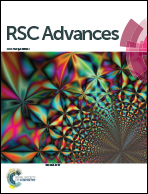Riboflavin-protected ultrasmall silver nanoclusters with enhanced antibacterial activity and the mechanisms†
Abstract
Developing silver nanomaterials with efficient antimicrobial properties is of importance for combating bacteria. Here, we report ultrasmall riboflavin-protected silver nanoclusters (RF@AgNCs) that can effectively kill or suppress the growth of Gram-positive S. aureus, Gram-negative E. coli, and fungi C. albicans. Riboflavin (RF) with intrinsic biocompatibility was used as a surface ligand to synthesize silver nanoclusters. TEM revealed that the synthesized RF@AgNCs were ultrasmall (2.4 ± 1.2 nm), spherical and well-dispersed. Antibacterial activity tests showed that RF@AgNCs possessed superior antibacterial efficacy in comparison with RF, AgNPs and mixed RF and AgNPs (RF + AgNPs). The mechanisms of antibacterial activity of RF@AgNCs were studied by fluorescence microscopy-based Live/Dead cell staining assays and ROS measurement. And the results illustrated that the integrity of the bacteria membrane was disrupted and intracellular high level ROS generation was induced by RF@AgNCs. The cytotoxic activities were also assessed and RF@AgNCs were found to be non-toxic to human red blood cells and mammalian cells. With the highly efficient antibacterial activity and acceptable biocompatibility, RF@AgNCs hold great promise in biomedical applications as well as in water sterilization and the textile industry.



 Please wait while we load your content...
Please wait while we load your content...